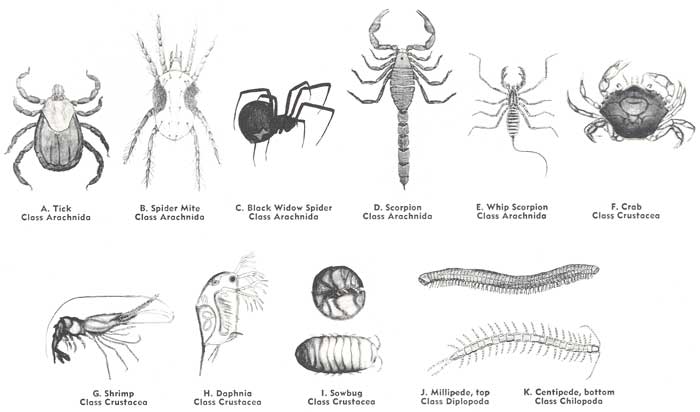NON-INSECT ARTHROPODS
In addition to insects, you may come across four other major groups of arthropods as you prepare your collection. Many of these animals are often mistaken for insects. If you count the number of legs and look at some basic characteristics, you will learn to recognize these creatures, too.
Class Arachnida
Within the class Arachnida are several common orders, including Araneae (spiders), Acari (ticks and mites), Opiliones (daddy-long-legs), and Scorpiones (scorpions), and more than 8,000 species in North America. Spiders (Fig. C) have two body segments-a cephalothorax and an abdomen, eight legs and usually eight eyes (although some may have fewer). Most spiders have venom glands located in their jaws, but only a few of the 2,500 species in the United States are considered dangerous. Ticks (Fig. A) have small oval bodies with very little evidence of separate body regions. When ticks first hatch, the larvae have only three pairs of legs. They acquire the fourth pair after the first molt. Two families of ticks-hard-bodied ticks and soft-bodied ticks-occur in North America. They are parasites that feed on the blood of mammals, birds and reptiles. Some ticks carry animal and human diseases. Mites (Fig. B) often look similar to ticks except that they are usually much smaller, sometimes microscopic. They have varied habits and life histories. They are often pests of plants and animals. Like mites and ticks, Daddy-longlegs have ovoid bodies with little separation between the abdomen and thorax, and are usually characterized by long, skinny legs. Daddy-long-legs are very common on buildings, in vegetation, and in caves. They feed on small arthropods. Scorpions (Figs. D, E) are often considered desert dwellers, but many species of scorpions live in the forest or jungle. They have eight legs in addition to a pair of pincher-like pedipalps. They have a long tail that ends in a bulb-like sting. All scorpions are venomous, but few are considered dangerous.
Class Diplopoda
Millipedes (Fig. J) are worm-like animals with many legs. They have cylindrical bodies. Most of the many body segments bear two pairs of legs, with most millipedes having more than 30 pairs of legs. Millipedes like damp environments and can be found under leaves, moss and rocks.
Class Chilopoda
Centipedes (Fig. K) have long flattened bodies with 15 or more pairs of legs. Most of their body segments bear only one pair of legs. Centipedes are found in similar environments as millipedes. Care should be taken when handling centipedes since they all have a poisonous bite.
Class Crustacea
Crustaceans include several orders of arthropods. Most of them are marine, but there are several fresh water and terrestrial members that live in Kentucky. Sowbugs (Fig. I) (order Isopoda), are very common. They are small (usually less than 15 millimeters long), brown or black in color and have seven airs of legs. Some sowbugs, called pillbugs, roll into a ball when disturbed. They are found in moist, cool areas, under leaves, moss and rocks. Crayfish, crabs (Fig. F), lobsters and shrimp (Fig. G) are all part of the order Decapoda. They typically have 19 pairs of appendages, although only five pairs resemble legs. The first of these five usually bear claws. This is a wellknown group because many of its members are used as human food.


